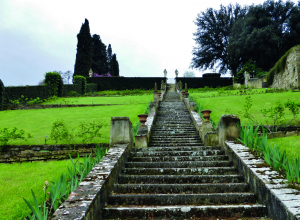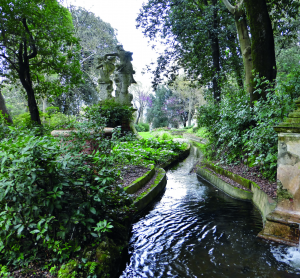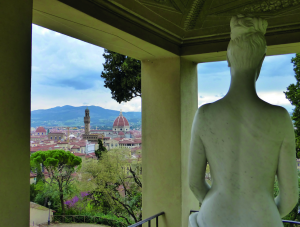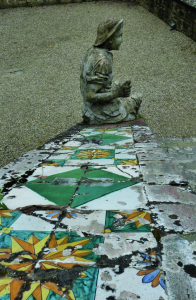Beyond the palazzo… now, rising elegantly up the slope was a series of manicured terraces, and a grand stairway climbing with them

Oltrarno means ‘beyond the Arno’, and refers to the part of Florence south of the river. Although you can find many famous sights there – the Pitti Palace, Boboli Gardens, and Piazzale Michelangelo among them – it attracts fewer visitors than the powerful tourist magnets on the other side: the Duomo, the Uffizi, Palazzo Vecchio, Michelangelo’s David, etc.
I thought I knew the area well. Years ago, I rented a flat on Costa San Giorgio, a narrow, cobbled road that snakes uphill from the Ponte Vecchio to the great Forte di Belvedere high in Florence’s southern hills. But recently, as I was crossing the Ponte alle Grazie toward the old Palazzo Mozzi on the Oltrarno side, I saw something that stopped me mid-bridge. Before, I had never noticed anything beyond the palazzo but a wooded hillside. Now, rising elegantly up the slope was a series of manicured terraces, and a grand stairway climbing with them. Two statues and the arcaded façade of a low building marked the top.
I was intrigued, of course. Across the bridge I stopped at the Museo Stefano Bardini to enquire. “Yes,” said a helpful lady there, “It’s the Giardino Bardini, very beautiful, very historical. You must go; the entrance is a due passi, in Via de Bardi.”
Indeed, not much more than the promised two steps away, I found the ticket office, paid my admission, and took a magical zig-zag path upward, past a rose garden, niches with weathered stone statues, and found a shaded path through a copse of holm oaks, with old stone benches to rest upon. As I climbed, I began to glimpse, through the trees, the Arno below, and the roofs of Florence stretching beyond. Every turn revealed more: the tower of Palazzo Vecchio, Giotto’s Campanile, Brunelleschi’s dome crowning Santa Maria del Fiore, and Santa Croce with its white façade in profile.

I had met no one at all thus far, and even when I found the forecourt of a rather large building – later, I found it was the Villa Bardini – it was deserted. Nearby, inside a small marble temple, was a statue of Aphrodite, gazing out over the river, toward Florence.

Continuing upward, I passed a mossy fountain feeding a small, winding canal, bordered with lush greenery and Baroque marble sculptures; and a path beside the stream led me to the medieval city walls of Florence, nearly covered with massed camellias. Nearby was a terrace at the top of the great staircase I’d seen from Ponte alle Grazie. The long building was there, too, with café tables under its arcade. Over to the east there was a pergola draped with wisteria, and beyond, the beautiful Romanesque façade of San Miniato al Monte. A few visitors stood at the terrace’s marble balustrade, entranced by a spectacular vista that rivals the iconic view from Piazzale Michelangelo.

Why had I not known of this remarkable place? The answer reaches back many centuries. There was a garden on the hillside as early as 1309, owned by the Mozzi, a trading family; it was probably partly ornamental and partly orchard. The property changed hands and its gardens changed shape often over the centuries. After a long series of owners, the property was acquired in 1913 by a wealthy antiquarian, Stefano Bardini, who redesigned the garden to display his collection. His son, Ugo, inherited the estate; when Ugo died in 1965, he willed it to the Swiss nation, and a long dispute over ownership began. It ended in 2000, when the property was acquired by the Fondazione parchi monumentali Bardini.
So the garden, with elements from so many eras, lay secret and virtually forgotten for 35 years, overgrown and forlorn. But the Fondazione, with support from a local bank, spent five years restoring it, and it opened in 2005. Now, more than a decade later, you can visit both Giardino Boboli and Giardino Bardini on the same combination ticket. Still, even now it seems only a relative few find their way to the gates of the once-forgotten garden.
